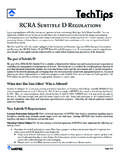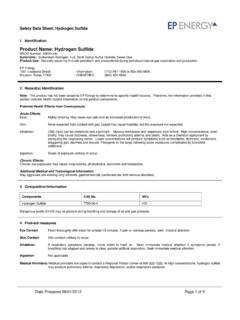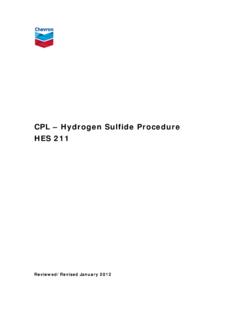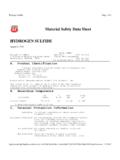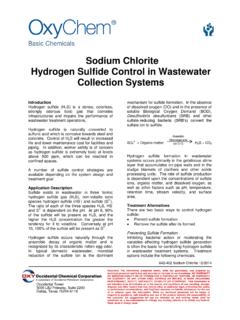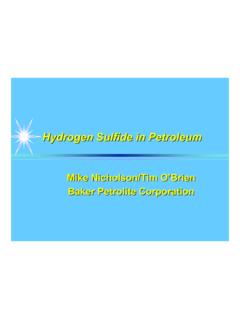Transcription of 1 PPM - 5000 PPM HYDROGEN SULFIDE IN …
1 Material Safety Data Sheet 1 PPM - 5000 PPM HYDROGEN SULFIDE IN. NITROGEN. Section 1: Product and Company Identification SpecAir Specialty Gases 22 Albiston Way Auburn, ME 04210. Phone: 207-784-5788. Toll Free: 800-292-6218. Fax: 207-784-5383. Product Code: 1 PPM - 5000 PPM HYDROGEN SULFIDE IN NITROGEN. Gas Name Concentration HYDROGEN SULFIDE 1 - 5000 PPM. Nitrogen to Chemical Chemical Trade Names Substance Family HYDROGEN HYDROGEN inorganic, HYDROGEN SULFIDE (H2S); DIHYDROGEN MONOSULFIDE; DIHYDROGEN SULFIDE ;. SULFIDE SULFIDE gas HYDROSULFURIC ACID; SULFUR DIHYDRIDE; SULFURETED HYDROGEN ; SULFUR. HYDRIDE; STINK DAMP; SEWER GAS; RCRA U135; UN 1053; H2S. Nitrogen NITROGEN, inorganic, DIATOMIC NITROGEN; DINITROGEN; NITROGEN; NITROGEN-14; NITROGEN GAS.
2 COMPRESSED GAS gas UN 1066; N2. Section 2: Hazards Identification Description Main Health Hazard HYDROGEN Colorless, rotten egg odor Harmful if inhaled, respiratory tract irritation, skin SULFIDE Flammable gas. May cause flash fire. Flash back hazard. Electrostatic irritation, eye irritation, blood damage charges may be generated by flow, agitation, etc. Nitrogen Colorless, odorless Difficulty breathing Containers may rupture or explode if exposed to heat. Likely Routes of Exposure: Inhalation Ingestion Eye Skin Health Effects Target Medical Organs Condition Aggravated by - HYDROGEN Irritation, lack of sense of Ingestion of Irritation, Irritation Harmful if Blood Eye disorders, SULFIDE smell, sensitivity to light, harmful sensitivity to liquid.
3 Inhaled, respiratory nausea, vomiting, difficulty amounts is light, visual frostbite respiratory disorders, breathing, headache, unlikely disturbances tract irritation, nervous drowsiness, dizziness, skin irritation, system disorientation, tremors, visual eye irritation, disorders disturbances, suffocation, lung blood damage congestion, internal bleeding, heart damage, nerve damage, brain damage, coma, death SpecAir Specialty Gases page 1 of 6. Generated by the MSDS Manager from AsteRisk, LLC. All Rights Reserved Generated: 08/08/2012 10:05:50. Inhalation Ingestion Eye Skin Health Effects Target Medical Organs Condition Aggravated by - Nitrogen Nausea, vomiting, difficulty Ingestion ofContact with No Difficulty Respiratory Pre-existing breathing, headache, a gas is rapidly information breathing system conditions of drowsiness, dizziness, tingling unlikely expanding gas on significant respiratory sensation, loss of coordination, may cause adverse system.
4 Convulsions, coma burns or effects frostbite This material is considered hazardous by the OSHA Hazard Communication Standard (29 CFR ). Section 3: Composition/Information on Ingredients CAS # % by Weight HYDROGEN SULFIDE 7783-06-4 1 - 5000 PPM. Nitrogen 7727-37-9 to Section 4: First Aid Measures Skin Contact Eye Contact Ingestion Inhalation Note to Physicians HYDROGEN Wash skin with soap and water for Flush eyes with If a large If adverse effects occur, remove to For SULFIDE at least 15 minutes while removing plenty of water for amount is uncontaminated area. Give artificial inhalation, contaminated clothing and shoes. at least 15 swallowed, get respiration if not breathing. If consider Get medical attention, if needed.
5 Minutes. Then get medical breathing is difficult, oxygen should oxygen. Thoroughly clean and dry immediate medical attention. be administered by qualified contaminated clothing and shoes attention. personnel. Get immediate medical before reuse. attention. Nitrogen Wash exposed skin with soap and Flush eyes with If a large If adverse effects occur, remove to For water. plenty of water. amount is uncontaminated area. Give artificial inhalation, swallowed, get respiration if not breathing. If consider medical breathing is difficult, oxygen should oxygen. attention. be administered by qualified personnel. Get immediate medical attention. Section 5: Fire Fighting Measures Suitable Extinguishing Media Products of Protection of Firefighters Combustion HYDROGEN Let burn unless leak can be stopped immediately.
6 Large Sulfur oxides Any self-contained breathing apparatus SULFIDE fires: Use regular foam or flood with fine water spray. with a full facepiece. Protective material types: butyl rubber, polyvinyl chloride (PVC), neoprene Nitrogen Non-flammable. Use suitable extinguishing media for Non-flammable Respiratory protection may be needed surrounding fire. Cylinders may rupture or explode if for frequent or heavy exposure. exposed to heat. Section 6: Accidental Release Measures Personal Precautions Environmental Methods for Containment Precautions HYDROGEN Keep unnecessary people away, isolate hazard area and deny Avoid heat, flames, Stop leak if possible without personal SULFIDE entry. Stay upwind and keep out of low areas. Ventilate closed sparks and other risk.
7 Remove sources of ignition. spaces before entering. Evacuation radius: 150 feet. For tank, sources of ignition. Reduce vapors with water spray. Do rail car or tank truck: 800 meters (1/2 mile). Do not touch not get water directly on material. spilled material. SpecAir Specialty Gases page 2 of 6. Generated by the MSDS Manager from AsteRisk, LLC. All Rights Reserved Generated: 08/08/2012 10:05:50. Personal Precautions Environmental Methods for Containment Precautions Nitrogen Keep unnecessary people away, isolate hazard area and deny No significant effects Stop leak if possible without personal entry. Stay upwind and keep out of low areas. from contamination risk. expected. Methods for Cleanup Other Information HYDROGEN Collect runoff for disposal as potential hazardous Notify Local Emergency Planning Committee and State Emergency SULFIDE waste.
8 Dike for later disposal. Absorb with sand or Response Commission for release greater than or equal to RQ ( other non-combustible material. Add an alkaline SARA Section 304). If release occurs in the and is reportable under material (lime, crushed limestone, sodium CERCLA Section 103, notify the National Response Center at (800)424- bicarbonate, or soda ash). 8802 (USA) or (202)426-2675 (USA). Nitrogen N/A N/A. Section 7: Handling and Storage Handling Storage HYDROGEN Store and handle in accordance with all current regulations and standards. Protect from physical Subject to handling SULFIDE damage. Store outside or in a detached building. Store in a cool, dry place. Store in a well-ventilated regulations: OSHA. area. Avoid contact with light.
9 Grounding and bonding required. Subject to storage regulations: 29 CFR OSHA 29 CFR Notify State Emergency Response Commission for storage or use at amounts greater than or equal to the TPQ ( EPA SARA Section 302). SARA Section 303 requires facilities storing a material with a TPQ to participate in local emergency response planning ( EPA 40 CFR. ). Keep separated from incompatible substances. Nitrogen Store and handle in accordance with all current regulations and standards. Subject to storage Keep seperated from regulations: OSHA 29 CFR incompatible substances. Section 8: Exposure Controls/Personal Protection Exposure Guidelines HYDROGEN HYDROGEN SULFIDE : 20 ppm OSHA ceiling 50 ppm OSHA peak 10 minute(s) (once if no other measurable exposure occurs) 10.
10 SULFIDE ppm (14 mg/m3) OSHA TWA (vacated by 58 FR 35338, June 30, 1993) 15 ppm (21 mg/m3) OSHA STEL (vacated by 58 FR. 35338, June 30, 1993) 10 ppm ACGIH TWA 15 ppm ACGIH STEL 10 ppm (15 mg/m3) NIOSH recommended ceiling 10 minute(s). TLV-TWA: 1ppm Upper respiratory irriation (ACGIH). Nitrogen NITROGEN, COMPRESSED GAS: NITROGEN: ACGIH (simple asphyxiant). Engineering Controls Handle only in fully enclosed systems. Eye Protection Skin Protection Respiratory Protection HYDROGEN Wear splash resistant safety goggles with a faceshield. Provide Wear appropriate Any self-contained breathing SULFIDE an emergency eye wash fountain and quick drench shower in the chemical resistant apparatus with a full facepiece. immediate work area.
